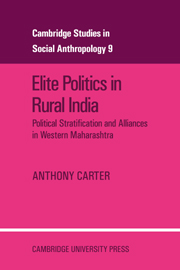 Elite Politics in Rural India
Elite Politics in Rural India from Part 2 - Aspects of political stratification
Published online by Cambridge University Press: 02 March 2010
As I noted in the previous chapter, much of the literature on political stratification in India centers on the notion of the ‘dominant caste’. According to Srinivas, the author of this concept,
A caste may be said to be ‘dominant’ when it preponderates numerically over the other castes, and when it also wields preponderant economic and political power. A large and powerful caste group can more easily be dominant if its position in the local caste hierarchy is not too low.
(1955:18)Mayer (1958a) observes that Srinivas's definition is concerned with aspects of dominance at the level of a single village, but that more inclusive levels of dominance also may be distinguished. Thus a caste is dominant in a region when it is dominant in a substantial majority of the villages of that region. A caste is dominant in the government of the district or state when it provides a substantial majority of the influential participants in institutions such as district councils, state cabinets, and so on. In some cases, as in Dewas Senior, there may be no regionally dominant caste. It is also possible for a caste to be dominant at a higher level of government without being dominant in the region. For example, in nineteenth-century Guntur District Deshastha (Maratha) Brahmins dominated the highest offices of district administration, while the British monopolized the Presidency administration, including Collectorships, but both groups were foreign to Madras and were without dominance at the village or regional levels (see Frykenberg 1965).
To save this book to your Kindle, first ensure [email protected] is added to your Approved Personal Document E-mail List under your Personal Document Settings on the Manage Your Content and Devices page of your Amazon account. Then enter the ‘name’ part of your Kindle email address below. Find out more about saving to your Kindle.
Note you can select to save to either the @free.kindle.com or @kindle.com variations. ‘@free.kindle.com’ emails are free but can only be saved to your device when it is connected to wi-fi. ‘@kindle.com’ emails can be delivered even when you are not connected to wi-fi, but note that service fees apply.
Find out more about the Kindle Personal Document Service.
To save content items to your account, please confirm that you agree to abide by our usage policies. If this is the first time you use this feature, you will be asked to authorise Cambridge Core to connect with your account. Find out more about saving content to Dropbox.
To save content items to your account, please confirm that you agree to abide by our usage policies. If this is the first time you use this feature, you will be asked to authorise Cambridge Core to connect with your account. Find out more about saving content to Google Drive.